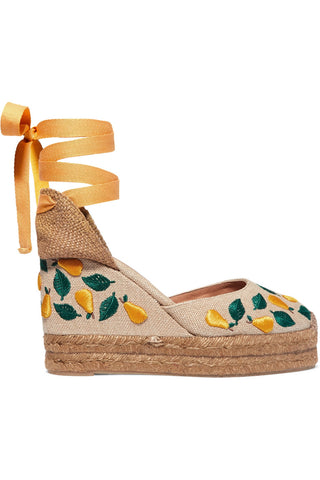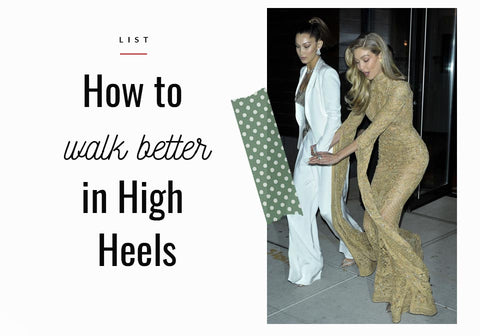
Here's a scenario every woman can relate to; you've got a special event coming up- maybe a job interview, or a wedding to attend. Whatever the reason, you feel like you should be wearing high heels- and you've got the perfect outfit to wear it with. But wait, there's a problem- you're not really comfortable in your high heels because you're a ballet flats-and-sneakers person on a day to day basis, or maybe, you just never cared for killer heels. Hey, maybe it's even your first time trying out high heels after deciding you want a change (and a little bit of height). Whatever your situation and reasons, we're going to show you EXACTLY how to walk in high heels in this massive, beginner-friendly guide. We'll also be answering all the most commonly-asked questions about high heels; from how your high heels should fit to giving you tips and tricks to make your high heel experience more comfortable. So let's begin!
Contents
- Why Can't I Walk in Heels?
- A Guide to Buying Your First High Heels
-
Comfy High Heels- the Easiest Heels For Beginners
- Most comfortable casual high heels
- Most comfortable dressy high heels
- Most comfortable black heels for work
-
Learning How to Walk in Heels
-
Preparation
- Practice walking on different surfaces and inclines
- Get used to heels with exercises
- Break in your heels
- Learn how to stand in high heels
-
Now You're Ready To Walk
- Heel, toe or toe, heel?
- Improve your posture
- Take small steps
- Take it slow and easy
- Final Steps- Heel the Pain
- Put them up
- Treat your feet to a mini massage
- Soak your feet
- Wear compression socks
-
Preparation
Why Can't I Walk in Heels?
You've now put on your high heels and taken a few tentative steps around the house. Instead of looking like a supermodel strutting effortlessly down the runway, your wobbliness suggests more newborn foal than graceful gazelle. If you find yourself in this position, relax- none of us were born with stilettos growing out of our feet! The reason why you can't walk in high heels, or why you're finding it very VERY difficult, is because high heels throw us off balance. Elevating our heels increases the amount of pressure placed on our foot, pushing our bodies forward and changing the way we balance and walk. This can put a strain on body parts and muscles which were previously not used to strain, and needless to say, it can make you feel awkward or clumsy. Now that we've established why walking in heels can be difficult, and that you're far from alone in your struggles, what's a determined girl to do?
A Guide to Buying Your First High Heels
Remember this, if you take away nothing else from this guide: Do not attempt to wear extremely high stilettos or very thin heeled shoes on your first attempt! Keep those for another occasion, preferably when you've mastered the basics of walking in heels and have some practice under your belt. Right now, following the tips below will help you find the easiest heels to walk in.
Walking properly in heels is more about balance than anything else. A lower heel will ensure your body isn't pushed too far forward, easing you into the "high heel walk" more gently than a 4 inch pointy toed heel. Bonus points for low heels placing less pressure, and therefore less pain on your ball of foot.
Referring to the former point about balance, a sturdy block heel gives you more support than a super thin high heel. Not only will you wobble less when you walk, but a block heel spreads out the impact you absorb when your feet hit the ground (heel first, in this case), meaning less pain for your back.
Pointy toe stiletto pumps might look great, but they often taper your foot too much. Walking around with toes all squashed together can be very uncomfortable- something you don't need at this stage in the game.
These work well because they are a good compromise between heels and flats as a dressier shoe option, but feature good foot support and a slighter pitch. A selection tip: the best wedges for beginner walkers are not too chunky, fit snugly or have adjustable straps, and come up around the ankles for greater support. Your best bet is one with the smallest "pitch", meaning the back of the heel is only slightly more elevated than the front. These options are best for your arches and great for beginners.
Even if you've always been the same size, the fit for sneakers and more flexible flats are more forgiving than high heels. Trying on your shoes in-person can alert you to the fact that instead of being a size 7, you might be a size 7 wide. Other shoe types can also feature more padding and flexibility, so trying on your heels at the store can get you used to a more structured shoe. As a last resort, if you simply must have a pair of high heels you found online, make sure the seller has a reasonable returns policy before you hit checkout.
Comfy High Heels- the Easiest Heels For Beginners
Most Comfortable Casual High Heels
|
|
$169 |
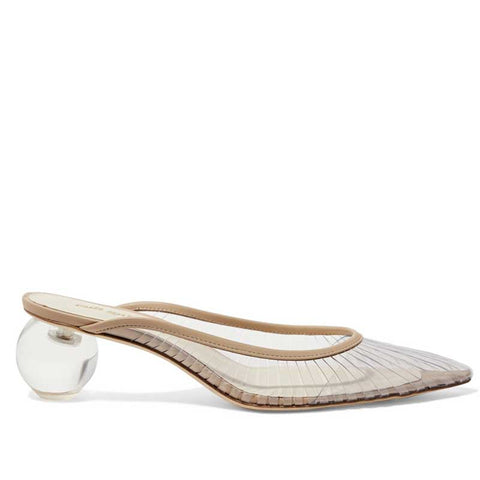 |
$325 |
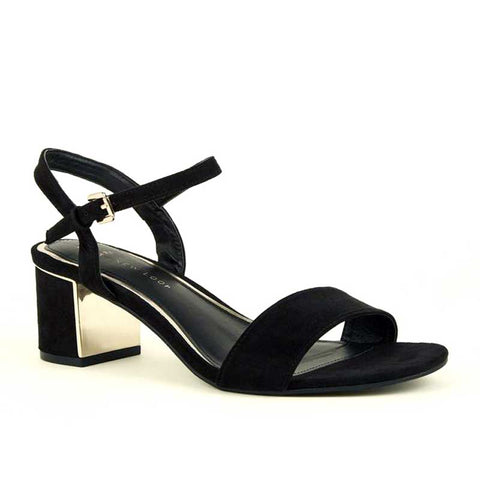 |
New Look Wide Fit Suedette Block Heel $25 |
Most Comfortable Dressy High Heels
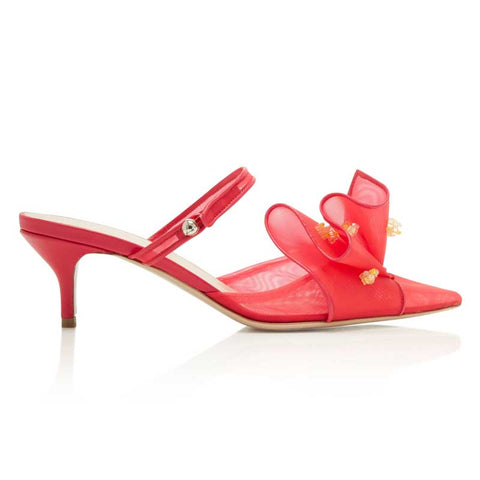
|
$820 |
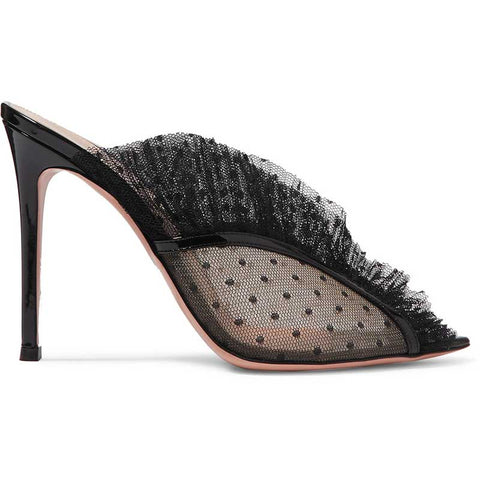 |
Gianvito Rossi Ruffled Point Mule $895 |
 |
Journee Collection Kalani Glitter Pump $49.99 |
Most Comfortable Black High Heels For Work

|
$860 |
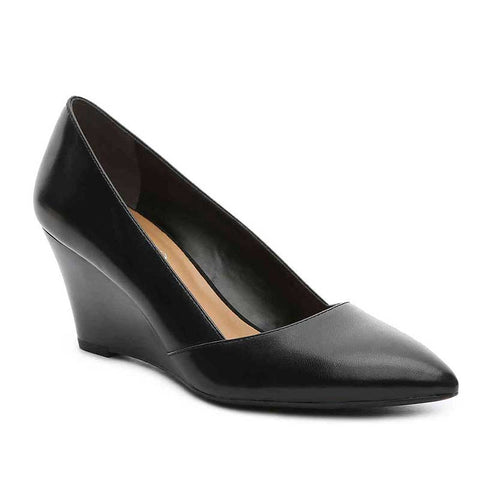 |
Franco Sarto Frankie Wedge Pump $59.99 |
 |
$59.99 |
Learning How to Walk in Heels (gracefully)
Preparation
Practice walking at home
Practice makes perfect, so wear your new high heels at home before debuting them. You'll want to practice walking on as many surfaces as possible- carpet, smooth floors, and up and down the stairs. A special note on stairs: when walking up stairs, only place the ball of your foot down on each step as you climb. when walking down however, place your entire foot down in the heel toe sequence, and make sure that you have a secure footing before placing the other foot down. Hold on to a railing, just in case.
Get used to your heels with exercises
Strengthening your ankles and joints will improve your high heel walk. A simple exercise you can do while watching TV is the standing calf raise. Stand with your feet hip distance apart: slowly rise onto the balls of your feet, then lower your heels back to the ground. Do three sets of 20 reps at your own pace. This will help you increase your ankle strength and get used to balancing in high heels.
Break in your heels
Stepping out in brand new shoes is a surefire way to get blisters. Breaking in your heels is the super important first step that lets you get used to walking in heels in the controlled environment of your home, and helps mold your new shoes to your feet. A simple way break your heels in quickly is to wear them around the house in thick socks. This will shape them nicely to your feet while stretching them slightly. If you find yourself in extra tight shoes, ramp this stretching action up a notch by combining wearing thick socks, wriggling your toes, AND blow-drying your heels.
Learn how to stand in high heels
This is a guide about walking better in high heels, but a lot of people don't know this: half the secret to heels is learning how to stand in them. It may sound silly, but many women don't know how to properly stand in heels when they are static, and this contributes to achy feet later on.
Now You're Ready To Walk
Heel toe or toe heel?
It sounds like a tongue-twister, but can be a useful reminder of proper walking gait in your heels. Beginners walking in high heels for the first time might be tempted to place the whole foot down at once as if you're still wearing flats. Given the pitch of the heels, that would result in a toe-to-heel landing- which is wrong. In high heels, the proper way to walk is reversed, so touch your heel to the ground, stabilize yourself and gently roll your foot forward to finish at your toe for a more natural walking gait.
Improve your posture
Wearing high heels will shift your center of gravity, meaning that watching your posture is more essential than ever. The following tips will help you correct and improve on your poise as you walk in your heels.
Women who attend yoga classes will be familiar with this visualization: while standing in heels, imagine a string extending from the crown of your head up to the ceiling/sky, pulling upwards. Your head should be stacked in line with your spine, and your shoulders should be held back instead of slouching forward. Keep your core engaged- in other words, suck your abdominal muscles in toward your spine- this will help you stand up straighter.
Keep your arms relaxed at your side, and swing them lightly back and forth while walking to help maintain your balance.
Bend your knees slightly when landing; this will protect your back from impact. Never lock your knees when walking in heels.
Imagine that you're walking along an invisible straight line; introduce a little shimmy to your hips. Place one foot (always observing the heel to toe rule) in front of the other, and try to keep your toes pointing straight ahead.
Take small steps
Due to the forward pitch of your heels and the rolling gait you'll have to adopt when walking, wearing heels shorten the length of your stride. As a rule, the higher the heel, the shorter your stride. Try to go with that and take smaller steps than you normally would- this helps you maintain your sense of balance.
Take it slow and easy
Between taking smaller steps and a compromised balance, its advisable to take your time while walking in heels. Budget a little extra time for getting from Point A to B when you're doing it in high heels. Being in a rush can result in an awkward forward leaning walk at best, and falling flat on your face at worst.
Final Steps- Heel the Pain
High heels hurt. We get it. It can be tempting to kick off your heels at the end of the day and collapse into bed, but a little post-high heel TLC for your feet can make a difference to whether you still have sore feet the next day or wake up feeling ready to tackle the world again.
Put them up
Elevating your feet helps prevent swelling, and facilitates faster healing of those sore foot muscles. To reap the benefits, simply lie down flat and prop your feet up at a 30 degree angle- either with pillows or a chair. Hold this position for at least 30 minutes while you read or use your phone.
Treat your feet to a mini massage
We don't all have the budget to book professional foot massages at the end of a long day in heels. An easy alternative that's just as effective is to use a ball or any hard, round object to roll under and at the sides of your foot. By doing this, you're breaking up the muscles and tiny fascia that have stiffened up due to pressure on your feet. Your feet will feel much more relaxed after a few minutes of rolling.
Soak your feet
Soaking in warm water for just 15 to 20 minutes can do wonders for your tired feet. A warm foot soak reduces inflammation (the soreness that you feel) and stimulates blood flow to your feet. Upgrade your foot soak by adding epsom salts for a skin softening boost, or add essential oils like lavender to aid in relaxation.
Wear compression socks
If you're too tired to do any of the above and simply want to tumble into bed, put on a pair of compression socks before you fall asleep. Compression socks are frequently worn on long flights to help blood circulate in your legs, and can confer the same benefits for your worn out feet while you sleep. This can go a long way in helping your feet feel fresh in the morning!
If your feet hurt in high heels...

Getting into high heels pushes our bodies forward and changes the way we balance and walk. While walking, your heel lands first in the heel-toe movement, impacting your back; and while stationary, you concentrate pressure on the balls of your feet- leading to the familiar feeling of slipping forward, as well as a burning-ball-of-foot sensation when you're in heels too long.
Good high heel insoles that add traction to your shoes and protect your feet can make a world of difference. Airpufs are high heel inserts cut from material originally invented by NASA. A foam that's been to space and back (literally!), our insoles are ultra impact absorbent, luxuriously soft, breatheable, and helps your foot grip on to your shoes better. You can read more about them here, or, because we are undoubtedly biased, read our reviews from happy customers.
We hope that our guide how to walk in high heels helps you walk a bit better and stand taller in the shoes you love. Please share this with your friends if you find it useful, and stay tuned for more high heel guides.

